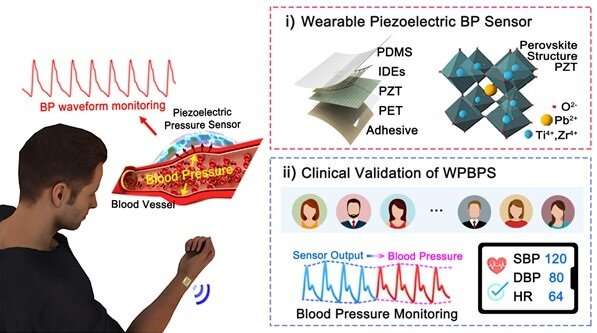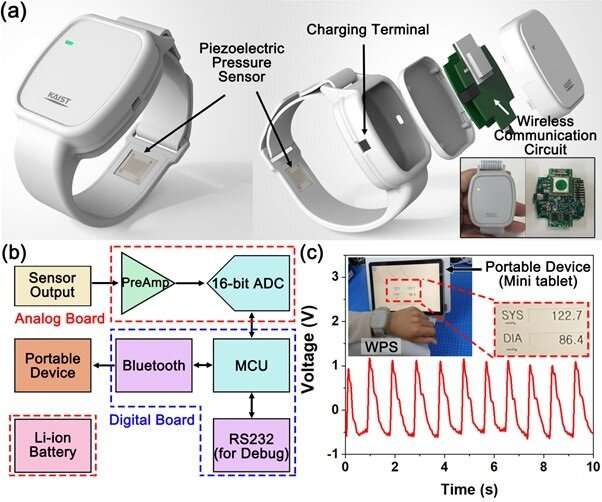This article has been reviewed according to Science X's editorial process and policies. Editors have highlighted the following attributes while ensuring the content's credibility:
fact-checked
peer-reviewed publication
trusted source
proofread
A highly sensitive, wearable piezoelectric blood pressure sensor for continuous health monitoring

A KAIST research team led by Professor Keon Jae Lee from the Department of Materials Science and Engineering and the College of Medicine of the Catholic University of Korea has developed a highly sensitive, wearable piezoelectric blood pressure sensor.
Blood pressure is a critical indicator for assessing general health and predicting stroke or heart failure. In particular, cardiovascular disease is the leading cause of global death; therefore, periodic measurement of blood pressure is crucial for personal health care.
Recently, there has been a growing interest in health care devices for continuous blood pressure monitoring. Although smart watches using LED-based photoplethysmography (PPG) technology have been on market, these devices have been limited by the accuracy constraints of optical sensors, making it hard to meet the international standards of automatic sphygmomanometers.
Professor Lee's team has developed the wearable piezoelectric blood pressure sensor by transferring a highly sensitive, inorganic piezoelectric membrane from bulk sapphire substrates to flexible substrates. Ultrathin piezoelectric sensors with a thickness of several micrometers (one hundredth of the human hair) exhibit conformal contact with the skin to successfully collect accurate blood pressure from the subtle pulsation of the blood vessels.

A clinical trial at the St. Mary's Hospital of the Catholic University validated the accuracy of blood pressure sensor on par with international standard with errors within ±5 mmHg and a standard deviation under 8 mmHg for both systolic and diastolic blood pressure. In addition, the research team successfully embedded the sensor on a watch-type product to enable continuous monitoring of blood pressure.
Prof. Keon Jae Lee said, "[A] major target of our health care devices is hypertensive patients for their daily medical check-up. We plan to develop a comfortable patch-type sensor to monitor blood pressure during sleep and have a start-up company commercialize these watch and patch-type products soon."
"Clinical validation of wearable piezoelectric blood pressure sensor for health monitoring" was published in the online issue of Advanced Materials on March 24, 2023.
More information: Seongwook Min et al, Clinical Validation of Wearable Piezoelectric Blood Pressure Sensor for Continuous Health Monitoring, Advanced Materials (2023). DOI: 10.1002/adma.202301627



















